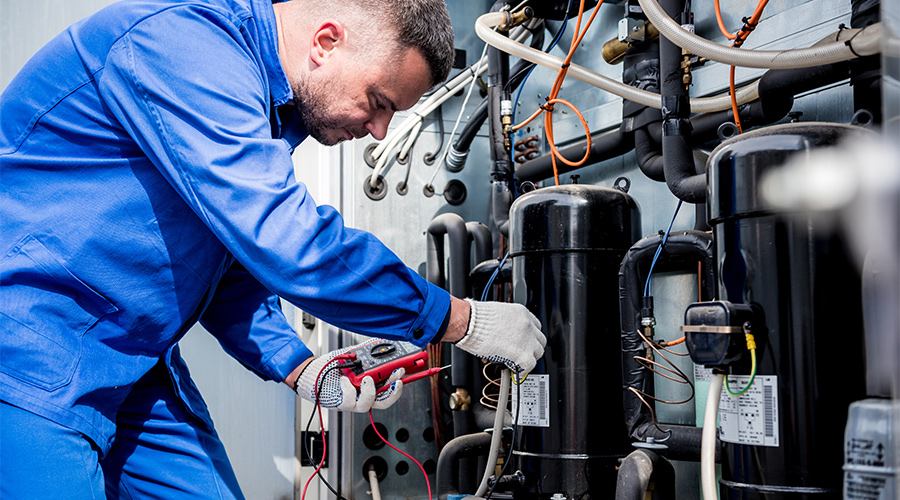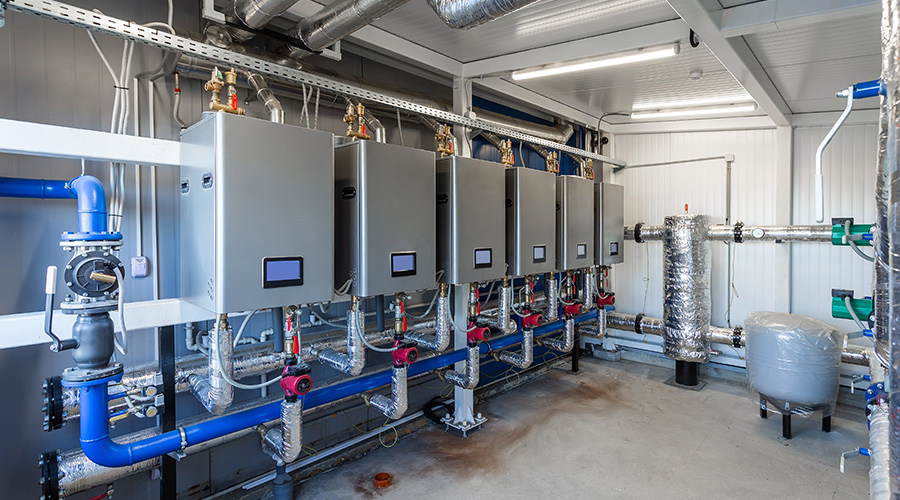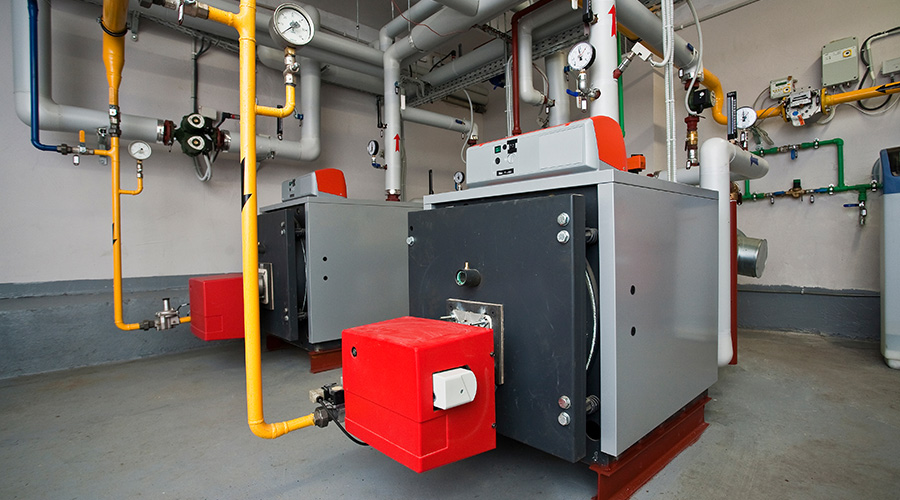Spot Cooling in a Crunch
Savvy decisions require that managers understand both needs and equipment options
The call for spot cooling is one maintenance and engineering managers never want to make. But for those who need to keep facilities, equipment and occupants at the proper temperature — often on short notice — it might be inevitable.
When people think of spot cooling, emergencies come to mind — and for good reason. Power outages, natural disasters, and heating, ventilation and air conditioning (HVAC) failures force managers to find cooling alternatives in a hurry. But the need for spot cooling extends well beyond emergency situations.
Managers with facilities containing computer and server rooms, portable classrooms, and single offices need to maintain desired temperatures that keep people comfortable and equipment running smoothly. Most 1-5 ton spot coolers — unlike the larger, more powerful units that can deliver 100 tons or more — seem simple to install and operate. Roll it in, plug it in, and stay cool. In reality, managers must weigh a series of important factors before calling for spot cooling.
Getting Started
The first question many manufacturers and distributors of spot cooling equipment will ask managers involves electricity.
“If I walked into a computer room, the very first thing I start looking at is electrical,” says Michael Thoele, sales manager for Trane Parts/LCU. “That’s right where I go right off the bat because you are limited by the amount of electrical power that you have in the room.”
The starting point is 110 volts. The largest spot cooler that can run on 110 volts has a 1.5-ton cooling capacity. But to run that machine on 110 volts requires nearly all of the circuit’s 15-20 amps. If an application requires a 2-, 3-, 4-, or 5-ton machine, using 110 volts is out of the question. The cooler an area or piece of equipment must be, the more electricity a manager will need.
“In a crunch, if someone’s calling us because their cooling failed, it usually is much more of a question of how many units can we power up based on the electrical power available, as opposed to what’s the ideal amount of cooling for the situation they’re talking about,” says Clark Michel, vice president of Atlas Sales & Rental.
The units’ cooling capacities generally are measured in two primary ways — tons and Btus. A 1-ton spot cooler produces 12,000 Btus, a two-ton unit produces 24,000 Btus, and so on.
Manufacturers also use other methods to determine the amount of cooling necessary. A general rule of thumb managers can use when determining capacity is that 400 square feet requires 1,000 Btus. The problem with that equation is that although a room is a certain size, it does not account for the amount of equipment filling the space. John Doran, senior manager at Denso Sales California Inc., looks at the equipment’s heat load to determine cooling capacity.
Doran multiplies the wattage output of a machine by 3.4. For example, if a computer puts out 1,000 watts, it requires about 3,400 Btus of cooling. Managers can compile the wattage output of an entire space to estimate the room’s cooling capacity.
“In terms of square footage and the heat load of the electronic equipment, those are all starting points,” Doran says. “You want to consider what ventilation is currently existing in that room, (and) if that room is relatively air tight or not. That would help determine where to place the cooling unit, what type of ducting you need.”
Key Considerations
Along with understanding electricity and cooling capacity, managers have to determine where the coolers’ byproducts — hot air and water — will go. With air-cooled machines, managers need to install ducts to vent the generated hot air out of the room. The coolers can have one or more ducts, and where the hot air will go is an important question to answer.
The machines also have water tanks that need emptying regularly, depending on humidity. Most smaller machines have a 5-gallon tank, and some larger units have a built-in removal pump. If technicians do not keep an eye on the tank’s water level, it can fill up, shut down the machine, and spill on the floor. If time allows, manufacturers and distributors will install a pump and a drain line to remove the water, eliminating the daily chore of emptying the tank. Water-cooled machines do not require ducting or emptying the water tanks because they transfer the heat to a water stream and a drain.
Hot Spots
With the colder temperatures looming, the requests for temporary air conditioning tend to slow down. But temporary heating will come into play in more facilities, so some manufacturers offer a selection of heat pumps.
All users need to do is turn up the thermostat, and the portable air conditioner becomes a heater. These 1-5 ton units aren’t used in heat-generating, equipment-heavy areas for obvious reasons, but they are designed to keep people warm in an emergency or when the HVAC system is not emitting enough heat. These smaller pumps are not sufficient for something like an outdoor construction site, but they generate enough heat for smaller applications, such as hospital rooms, single classrooms and offices.
Rent or Buy?
Although spot coolers originally were designed for temporary cooling purposes, they often become permanent fixtures in a facility. If a computer room or small office needs cooling throughout the year, managers must decide whether to continue renting or commit to buying.
In emergency situations, renting seems to be the obvious choice because managers often cannot take time to go through the purchasing process.
“The rental business is, ‘Do you have it in stock and how fast can you get it there?’ ” Thoele says.
But for those who need cooling for an extended period of time, the process is more complex. If facilities need the machine for a few months or more, purchasing is the economically smart decision. The cost to rent during the summer months might be higher in some cases than buying the product outright. But as every manager knows, making a large purchase involves more than dollars and cents.
Thoele has worked with managers who understand they lose money in the long run by renting, but do so because they don’t want to deal with the process of getting the transaction approved. Renting — whether for one, two, or three years or longer — avoids a capital expense.
Choosing a Partner
The spot cooling business is competitive, so choosing who to buy or rent the product from is another important decision managers face. Depending on a facility’s location, a manager might have limited options in finding a company. But larger cities give managers more manufacturers and distributors from which to choose.
“All the manufacturers are pretty much the same, (and) all the price points are pretty much the same,” Thoele says. “So it really boils down to, who does the best job in their marketing, who does the best job in their customer service.”
Many distributors are responsible for installing the spot coolers and providing service. Some distributors are part of a larger company that has spot coolers in its portfolio, while others work with only the 1-5 ton machines.
Spot Coolers, which has 37 branches nationwide, focuses its attention on the smaller units. Garth Tagge, Spot Coolers’ vice president of sales, says specialization can help guide customers through the purchase process.
“We’re specialists; it’s all we do,” he says. “We deal in portable air conditioning. We’re experts. It’s our entire focus.”
Thoele works under the Trane umbrella, but he operates his spot cooling business inside one of the company’s parts stores in Texas. He is responsible for customers in certain cities in Texas and Oklahoma, and Trane has similar arrangements across the United States.
Atlas Sales & Rental has 15 locations — primarily in major metropolitan areas — but Michel says the company plans to expand. The bottom line is, when managers have to inquire about spot cooling, someone in the area will be more than willing to answer their questions.
Says Tagge: “What happens is, if you don’t know, you call.”
Emergency Cooling:
Asking the Right Questions
Spot cooling distributors do not expect facilities managers to be experts.
“We see it all,” says Clark Michel, vice president of Atlas Sales & Rental. “We see everyone from a person who has no clue what they need, to someone with more experience who knows what he needs.”
But in an emergency, if managers know the questions a distributor will likely ask, they can solve the problem more efficiently. Here are a few things – outside of electricity, cooling capacity and air and water removal – managers should know before calling a distributor:
Space constraints. If a manager is trying to cool a computer or server room the size of a closet, he must determine where the spot cooler will sit. For applications that need year-round cooling, the machine cannot be in front of the door or in a walkway. Instead of one larger, more powerful machine, two or more smaller coolers might be the only option.
Location. If the application is in a basement, multi-story building or a secure location — such as a post office or prison — there is little or no chance to duct the hot air out of the room. If that is the case, a water-cooled machine might be the best option.
Timing. In an emergency, if a manager cannot answer these questions, a distributor can install a temporary machine, at least until things settle down. Once the situation is under control, the distributor can analyze the problem further and determine a more permanent solution.
“Let’s say you walk in, talk to a facilities manager and they have a computer room,” says Michael Thoele, sales manager for Trane Parts/LCU. “Some of the first questions you’re going to ask is, ‘How quick do you need something?’
“That’s going to have a huge impact on what you’re doing. You can spend night and day figuring out a whole bunch of stuff, but if the answer is, ‘Today,’ that changes the ball game a little bit.”
— Chris Matt
|
Related Topics:











